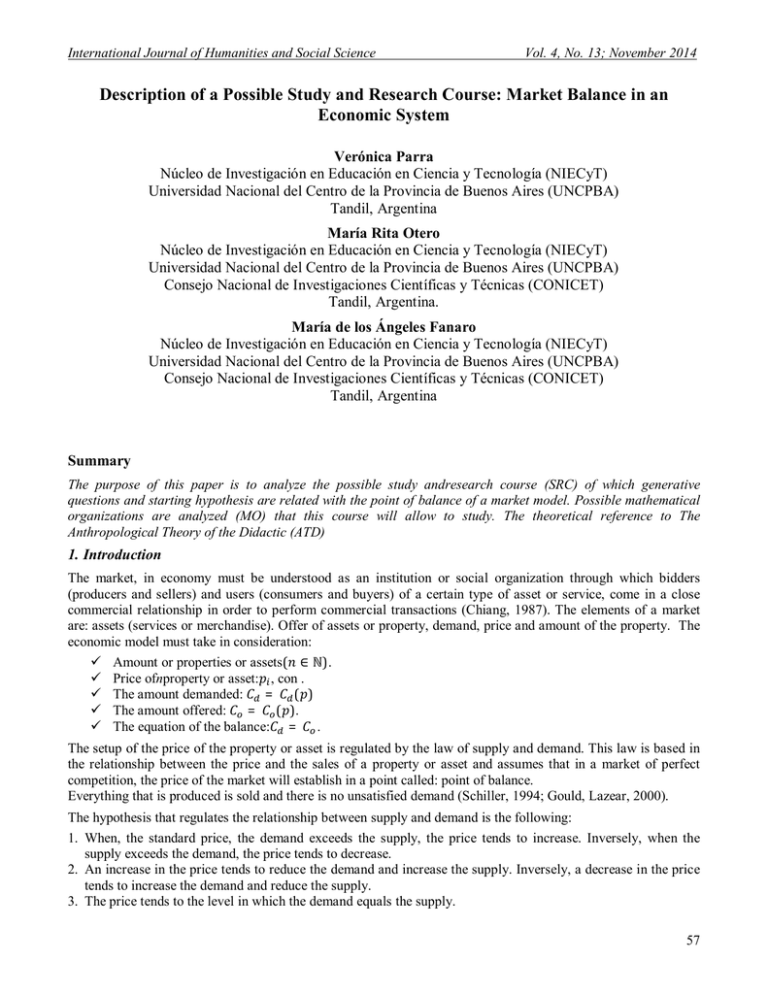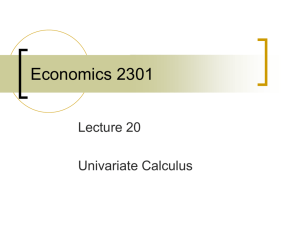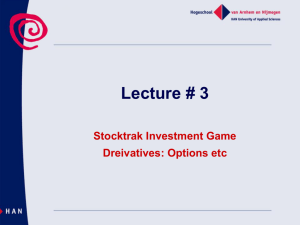Document 10466123
advertisement

International Journal of Humanities and Social Science Vol. 4, No. 13; November 2014 Description of a Possible Study and Research Course: Market Balance in an Economic System Verónica Parra Núcleo de Investigación en Educación en Ciencia y Tecnología (NIECyT) Universidad Nacional del Centro de la Provincia de Buenos Aires (UNCPBA) Tandil, Argentina María Rita Otero Núcleo de Investigación en Educación en Ciencia y Tecnología (NIECyT) Universidad Nacional del Centro de la Provincia de Buenos Aires (UNCPBA) Consejo Nacional de Investigaciones Científicas y Técnicas (CONICET) Tandil, Argentina. María de los Ángeles Fanaro Núcleo de Investigación en Educación en Ciencia y Tecnología (NIECyT) Universidad Nacional del Centro de la Provincia de Buenos Aires (UNCPBA) Consejo Nacional de Investigaciones Científicas y Técnicas (CONICET) Tandil, Argentina Summary The purpose of this paper is to analyze the possible study andresearch course (SRC) of which generative questions and starting hypothesis are related with the point of balance of a market model. Possible mathematical organizations are analyzed (MO) that this course will allow to study. The theoretical reference to The Anthropological Theory of the Didactic (ATD) 1. Introduction The market, in economy must be understood as an institution or social organization through which bidders (producers and sellers) and users (consumers and buyers) of a certain type of asset or service, come in a close commercial relationship in order to perform commercial transactions (Chiang, 1987). The elements of a market are: assets (services or merchandise). Offer of assets or property, demand, price and amount of the property. The economic model must take in consideration: Amount or properties or assets( ∈ ℕ). Price ofnproperty or asset: , con . The amount demanded: = ( ) The amount offered: = ( ). The equation of the balance: = . The setup of the price of the property or asset is regulated by the law of supply and demand. This law is based in the relationship between the price and the sales of a property or asset and assumes that in a market of perfect competition, the price of the market will establish in a point called: point of balance. Everything that is produced is sold and there is no unsatisfied demand (Schiller, 1994; Gould, Lazear, 2000). The hypothesis that regulates the relationship between supply and demand is the following: 1. When, the standard price, the demand exceeds the supply, the price tends to increase. Inversely, when the supply exceeds the demand, the price tends to decrease. 2. An increase in the price tends to reduce the demand and increase the supply. Inversely, a decrease in the price tends to increase the demand and reduce the supply. 3. The price tends to the level in which the demand equals the supply. 57 © Center for Promoting Ideas, USA www.ijhssnet.com Depending on the amount of assets or property that are considered and depending on the nature of the supply and demand functions involved, the economic models to build will be different. This paper will present a possible study and research course (SRC) (Chevallard, 2013) and the questions will be provided by microeconomics, specifically of models of supply and demand. The setup of the models will allow to study different mathematic organization (MO) in regards to the functions involved. The starting point hypothesis are analyzed, the questions that may be made under that hypothesis and the MO that can be studied to grant answers to those questions. An example is developed of a MO case that can be built to give an answer to a question: the MO in regards to the questions. 2. Study and Research Course: Hypothesis and Generative Questions The notion of balance in a market model is classified in accordance to accessibility. We can suppose beforehand that the balance sate is reachable or we cannot suppose anything of the sort. The first case gives two types of economic analysis: the static analysis en the comparative- static analysis.The first one is focused in the search of the state of balance, precisely in finding values of the variables that satisfy the balance: how to find the price and the amount of balance in which there is no excess of supply or shortage in demand?The second analysis is a comparison of different states of balance associated to different groups of values of the parameters and of the variables of the model.That is why we always start assuming an initial sate of balance and then a change of balance is performed in the model- with a variation in the value of any parameter.Subsequently both states of balance are compared: when and how is the position of the balance modified in response to a certain change in the parameter of the model?The second case where no one knows about the accessibility of the balance, gives place to a dynamic analysis. In this analysis we have to add the “time” variable. In consequence, what can happen due to the instability of the model, the new balance is never reached. So the following question is asked: will the model reach the point of balance? If there are different balance values, the more suitable one will be chosen among all of the possibilities. This leads us to the analysis of ideal choice or final balance. The best choice will depend of the objective that we want to reach. The OM in regards to optimization and the mathematic programing will give an answer to these types of problems.In its most simple form, this equals to solve the problem of the following type ) ( ) max( ∈Ω⊆ℝ Where = ( , , … , )is the vector of the decision variables; ( )the function objectiveandΩthe group of decision and restrictions of the problem.When groupΩis represented by restrictions of the form ( , , … , ) = 0, the MO to be built corresponds to the relative of the mathematical optimization. When groupΩ is formed by restrictions of the form ( , , … , ) ≥ 0, ( , , … , ) ≤ 0, ( , , … , ) > 0 o ( , , … , ) < 0, the MO corresponds to the mathematical programing. When there is a sole value of balance, thebalance will be called not finalist. In this case, the partial balance and general balance are differentiated.The first one consists in considering a market formed by one sole asset or property, so the model will consider only the price of that asset or property. The second will consider the price of nproperty or asset being ∈ ℕ, > 1. In the case of partial balance, the model to be built will have the following equations: the function of the supply ( ), the function of the demand ( ) of the property or asset, both dependent on the price ( ) of the property or asset and the equation of the balance: ( ) ( ) ( )= ( ) In the case of the general balance the model to be built will have the following equations:The function of the supply ( ),the function of the demand ( ) of each asset or propertyi ( = 1,2, … , ), all dependent on prices ( ) of thenassets or properties and the equation of balance. The model is built by the following manner: ( ,…, ) ( ,…, ) ( ,…, ) = ( ,…, 58 ) International Journal of Humanities and Social Science Vol. 4, No. 13; November 2014 With = 1,2, … , . This model has2 functions;in which are not necessarily linear. When adding the balance condition, the model is completed with a total of3 equations. However, replacing the functions and inthe balance equation, the model can be reduced to a total of nsimultaneous equations. Called to the balance equations, the group of the previous equations can be described as: ( , ) = 0, ,…, = 1,2, … , Solving simultaneously thesen equations, thenprices of balance will be determined. Then, the amount of balance will be deduced from each price of balance. This gives place to the MO of the matrix algebra. Later on we will give an example of how these hypothesis and issues of micro economy will allow to enter the study of MO of the derivate. 3. A linear Model of Supply and Demand: Functional Study of the MO Involved We consider both functions of offer and demand to be linear.The market model will have the following shape: ( )= − + ( )= − ( )= ( ) Parameters a, b, c and d must be positive so the model will verify the models of law of supply and demand. The supply function has negative vertical intersection, in – c since the supply curve is forced to have a positive horizontal intersection, in , and in consequence satisfies the condition that the supply is not less, that the pricey to be sufficiently positive and high.Once the model is built, the following step is to obtain the solutions of price variables and amount that satisfy the balance. Solving the system we obtain the solutions called reduced forms that correspond to the price ( ) and the balance amount( ): = and = (Figure 1) To find how infinitesimal change will affect one of the parameters to the price value a ( ) and the balance amount ( ) we just have to differentiate partially the reduced forms in regards to each parameter.Resolving the sign of the partial derivative, from the relative information given to the parameters, we know the direction of change. Anyhow, we can conclude about the balance amount. Let’s make an example with just . The four partial derivatives using the reduced form = , are the following: = ; =( ( ) ) ; = ; =( ( ) ) All parameters are restricted to be positives, so we can conclude that: = >0; = <0 These derivatives show: – The change relation between andais direct: this means, ifaincreases (decreases) so also increases (decreases). This is obtained since the derivate in in regards toais positive. The same conclusion is obtained for derivate of regardingparameterc. – The change relation between andbis inverse: meaning, ifaincreases (decreases) then decreases (increases). This is obtained since the derivate in regarding tobis negative. The same conclusion is obtained for derivate of regarding parameter d. We have to calculate the derivate for . Graphically these conclusions can be obtained.For example let’s analyze the case in which we changed parameterc (Figure 2). In this way, not only do we arrive to conductions about the variations but also we can study the behavior of the charts of the functions of supply and demand. This is an example where both functions are linear but it is important to mention that they may not be. The supply and demand functions can be of any type. We just have to check the supply and demand. The selection of the nature of the functions will depend of the functions that are to be studied or of the proposed functions in the study programs.If the program study doesn’t include partial derivate, this analysis can be done with the derivate of the functions of one variable of the following way: three of the models of parameters are set and changed one at a time. 59 © Center for Promoting Ideas, USA www.ijhssnet.com This is an example where functions are both linear, but it is important to mention, that they may not be. For example, we could consider that the functions of supply are a polynomial function of grade 2, with is relative domain at the vertex of the function and its positive main coefficient.The demand function could also be a polynomial function of grade 2 with its relative domain at the vertex and its negative main coefficient.With these restrictions we can check the offer and demand law ( )= − ± + ( )= ± − ( )= ( ) The variations of the parameters of the model can be done using chart or numeric methods. The Figure 3 corresponds to the variations in the independent term of the curve of demand. The selection of the functions will depend on the study programs and choose the one we want to study. If a study program doesn’t have partial derivate, this analysis can be done from a derivate of functions of a variable of the following way:let’s see one example. Let’s suppose that the supply and demand model related is the following: ( ) = −10 + 400 ( ) = 19 − 35 ( )= ( ) The point of balance of this model is given by( ; ) = (15; 250). Let’s suppose that we want to resolve how and how much does this point of balance changes exactly, if the ordinate of the line of demand changes. This analysis can be done graphically but if we want to calculate how much thepoint of balance it will be necessary to use the derivate. Considering the related general model, in this case we would have to = 10, = 400; = 19 35.Replacing in the reduced forms he values of the parametersa, bandd, we would have to = and × × = = . We don’t replace in parametercsince it the one that changes. When doing the calculations we find that = and = . So the price and the amount of balance are expressed in the function of the parameterc. Differentiating both expressions we get the variation of the point of balanced pending on the variation of parameterc: = and = . So we conclude that when a parameter in c changes in a unit, the price of balance increases units (derivate is positive) and the amount of balance decreases This analysis can be done for all of the parameters of the model. units (derivate is negative). A brief example hasbeen showed of the MO that can be studied starting from the questions of Micro economy such as MO relative to the affine functions along with relative MO to functions, the MO of equation systems and the MO in regards to limit and derivate. 4. Conclusions In this paper the first face of relative didactic engineering were characterized briefly relative to the construction of possible study and research course which starting point questions and hypothesis come from micro economy. Different mathematical organization were presented that could be built to give answers to questions. It was shown, also, with an example, how derivate of functions can be studied in the secondary school from the variability along with linear equations. The purpose of this is to study mathematical organizations as consequence of the need in the construction and analysis of the model to give answers to the different issues that can arise. A similar course has been implemented in the secondary school with promising results. In this way function relationships were given with the mathematical knowledge, recuperating a sense and reasonto be. 60 International Journal of Humanities and Social Science Vol. 4, No. 13; November 2014 References Chevallard, Y. (2013), Journal du seminaire TAD/IDD. Théorie Anthropologique du Didactique & Ingénierie Didactique du Développement. [Online] Available: http://yves.chevallard.free.fr/spip/spip/IMG/pdf/journal-tad-idd-2012-2013-1.pdf(March 3, 2014) Chiang, A. (1987). Métodos fundamentales de la economía matemática.(1rd ed). México: McGraw-Hill, (Chapter 1). Figure 1: Representation of a Linear Model Figure 2: Variation in the Scale of the Offer Function Figure 3: Variation in the Nonlinear Model 61


